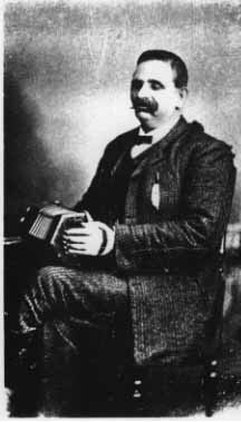The concertina
|
A concertina is a hand-held, bellows driven free-reed instrument. In contrast with the accordeon, the buttons are placed in the same direction as the bellows and also at both ends of it. Each button produces one note. The word "concertina" refers to instruments constructed according to various systems: concertinas are six sided, aeolas are eight sided and edeophones are twelve sided.
The concertina was developed in England and Germany almost simultaniously. Sir Charles Wheatstone patented his first version of the instrument in 1829 and in 1844 he patented an improved version. Carl Friedrich Uhlig announced the German version in 1834. As the concertina was developed in England and in Germany at the same time, we do know English, German and Anglo-German types. |
This existance of different types also means there are quite some differences between the concertinas. They may differ in
- availability of notes and ranges
- positioning of the buttons
- notes may be bisonic (different sound on push and draw) or unisonic (same sound on push and draw)
- ability to produce sound in both bellow directions. The single action is mostly found on English bass and some baritone instruments.
- the size of the instrument and the technique required to hold it
- types of reeds
- the mechanical action that opens and closes the valves to the reed chambers.
|
The English concertina is a unisonoric, fully chromatic instrument. It has buttons in a rectangular arrangement of four staggered rows, with the short side of the rectangle addressing to the wrist.
The two innermost rows constitute a diatonic C major scale, distributed alternately between the two sides of the instrument. This means that the notes C, E, G, B, d are on one side and D, F, A, c, e are on the other. The two outer rows consist of the sharps and flats required to complete the chromatic scale. The English concertina is typically held by placing the thumbs through thumb straps and the little fingers on metal finger rests. This leaves three fingers free for playing. In the classic style of Regondi the little fingers are used too for playing and the metal finger rests are only used very occasionally. This method allows the player to use all eight fingers, so larger chords become possible. The English-system treble and tenor-treble usually span 3.5 or 4 octaves. Baritones are similar but transpose down one octave. Bass concertinas transpose two octaves down and piccolo concertinas transpose one octave up. The keyboard stud-arrangement is the same throughout, so concertina band players can all play from music in treble clef and it is easy to move from smaller to larger instruments. |
The most common features on a row for the English concertina:
German concertinas usually do use more than one reed for each note, this for producing a fuller sound. Depending on the manufacturer, each note may have up to five reeds spread across the three octaves. Sometimes these reeds are slightly out of tune with each other in order to create a vibrato effect, called wet, musette or Chicago tuning. Dry or Minesota tuning means the reeds are in tune with each other and do not produce the vibrato effect.
The most common features of the German concertinas are:
Sources: http://en.wikipedia.org/wiki/Concertina
- unisonoric
- fully chromatic
- reeds individually mounted on a frame, laid flat on a chambered reedpan with a pair of reeds in each chamber
- each button has a pivot
- hexagon shaped ends
German concertinas usually do use more than one reed for each note, this for producing a fuller sound. Depending on the manufacturer, each note may have up to five reeds spread across the three octaves. Sometimes these reeds are slightly out of tune with each other in order to create a vibrato effect, called wet, musette or Chicago tuning. Dry or Minesota tuning means the reeds are in tune with each other and do not produce the vibrato effect.
The most common features of the German concertinas are:
- bisonoric (different note on push and draw of the bellows)
- diatonic or semichromatic
- reeds mounted on a long plate, separate chambers for each set of reeds
- buttons in each row pivot or shared pivot arm
- square ends
Sources: http://en.wikipedia.org/wiki/Concertina


